Neuroimaging Gives Researchers Insight into OCD
Images

Researchers from Zhejiang University School of Medicine have revealed key connections between clinical characteristics, neuroimaging and treatment, in an effort to better understand obsessive-compulsive and related disorders (OCD), heralding new opportunities for improved diagnostic and therapeutic strategies. The study was published in Psychoradiology.
The study involved a comprehensive review of the concept of insight in OCD, exploring its clinical characteristics, corresponding changes in neuroimaging, and how insight relates to treatment effectiveness. Insight in OCD refers to the patient's awareness of their thoughts and behaviors as symptoms of a disorder. Notably, about 13–36% of patients show poor insight, linked to more severe symptoms and poorer treatment outcomes.
Neuroimaging studies have played a pivotal role in understanding the neurological basis of insight. Structural and functional abnormalities have been observed in critical brain areas, including the frontal, temporal, and parietal lobes. Specifically, reduced cortical thickness in the dorsal medial prefrontal cortex, left anterior cingulate cortex, and right lateral parietal cortex has been associated with poor insight. These findings suggest that insight-related changes might reflect a reduction in neurons within cortical columns.
Although treatment like CBT and pharmacotherapy have shown some effectiveness in enhancing insight, the response to these treatments varies, emphasizing the need for personalized treatment strategies. Neuroleptics and atypical antipsychotics, often prescribed to patients with limited insight, have yet to show consistent effectiveness.
The study's leading researcher highlighted the importance of this study: “Our research not only advances our understanding of the neural underpinnings of OCD but also opens up new avenues for targeted treatments. By identifying specific neural networks associated with OCD severity, we can develop more personalized and effective interventions.”
The implications of this research are profound. By enhancing our understanding of the neural mechanisms underlying OCD, this study paves the way for more precise and personalized treatment approaches. It also underscores the potential of Connectome-based Predictive Modeling and other data-driven multimodal fusion techniques in psychiatric research, promising to transform diagnostic and therapeutic strategies for OCD and other complex psychiatric disorders.
Related Articles
Citation
Neuroimaging Gives Researchers Insight into OCD. Appl Radiol.
January 18, 2024